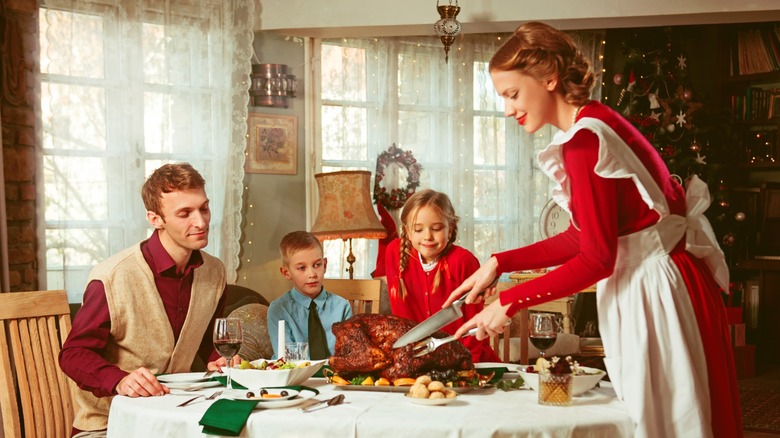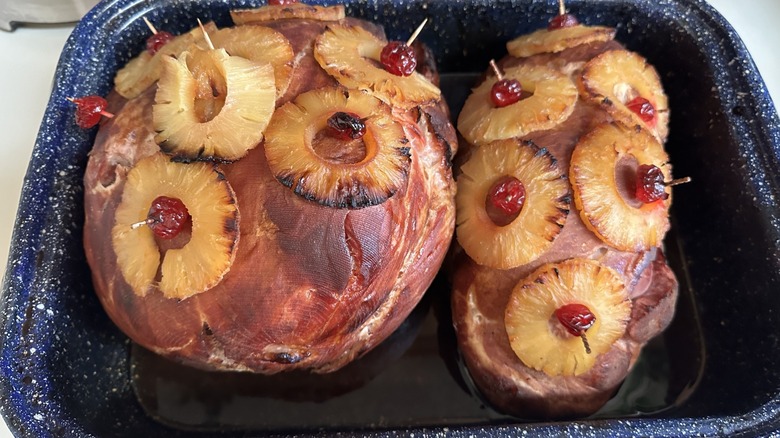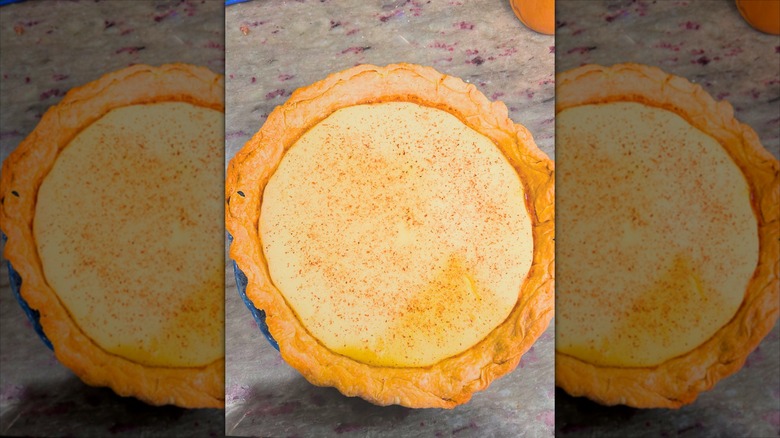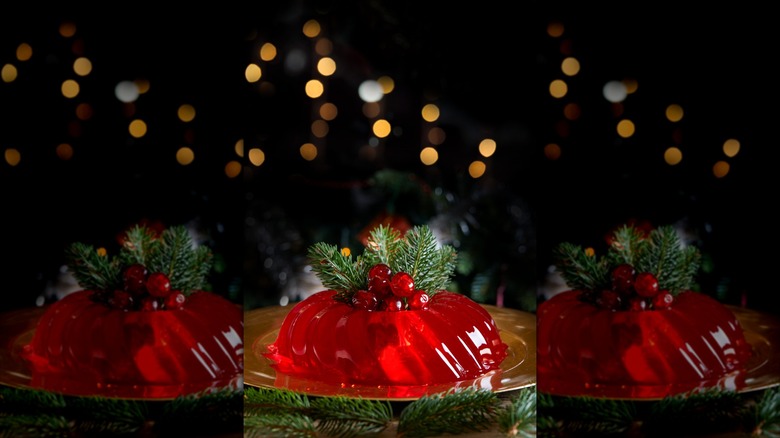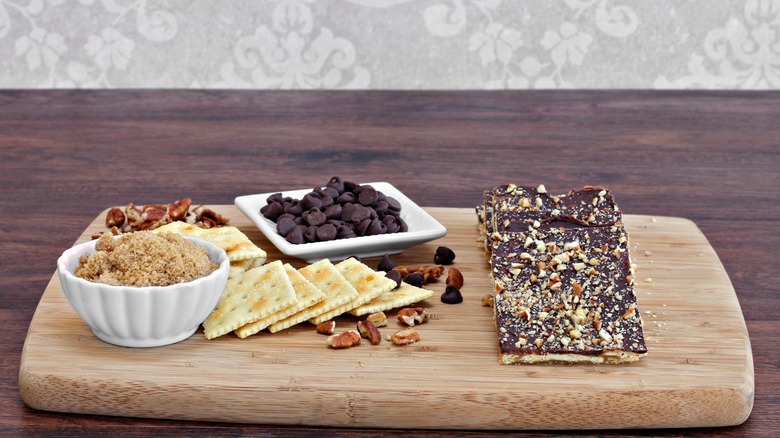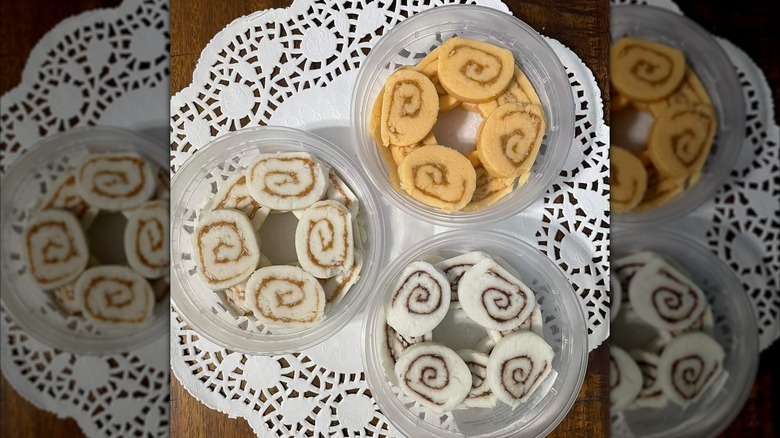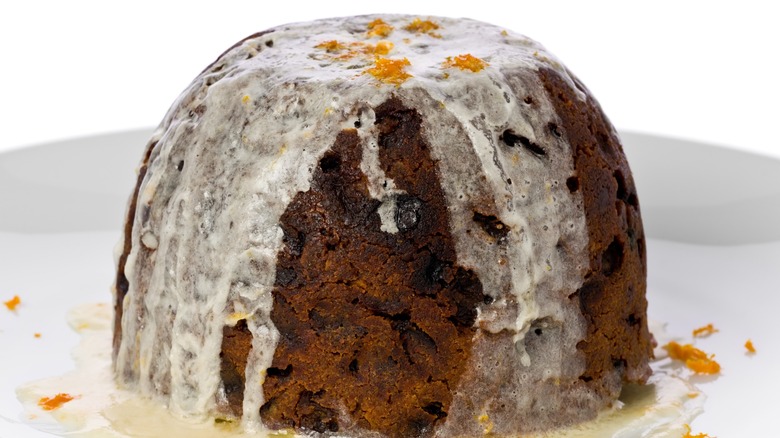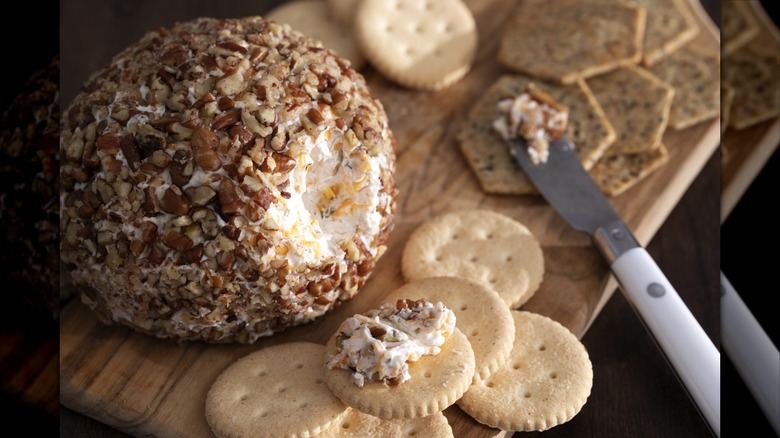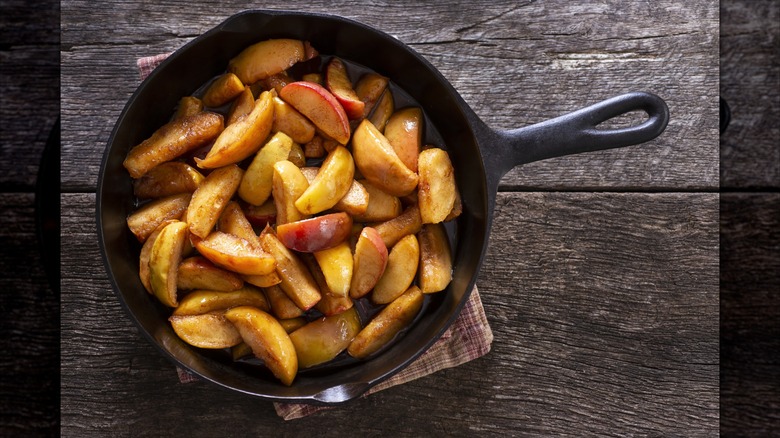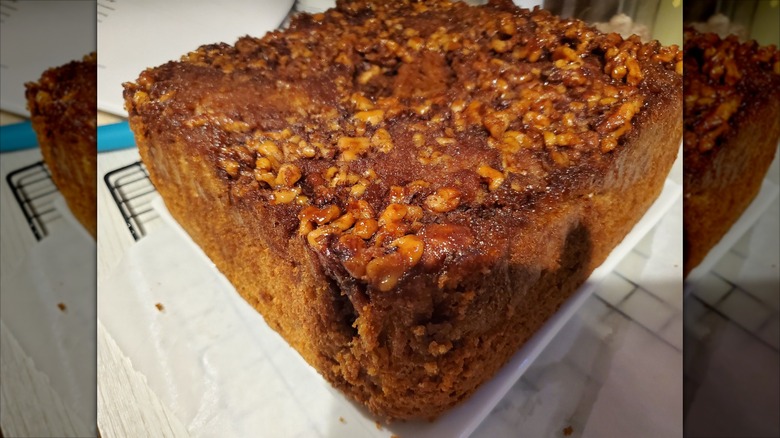Old-School Christmas Dishes Almost Everyone Has Forgotten About
There's something about nostalgia that makes us reach back, like all the way back, to childhood and all things that we recollect as lovely and good. The crackle of an old-school radio, the scratch of vinyl on that vintage francophone — you know the stuff. Holidays are a special niche of nostalgia, where good things included cider simmering on the stove and the scent of cinnamon wafting from the kitchen from some made-from-scratch Christmas miracle mom had just whipped up seemingly out of thin air (or with whatever was in the pantry). Remember when Christmas wasn't about extravagance but about families making do, stretching what was on hand, and somehow still making it feel magical?
Our memories are filled with flashbacks of those crazy technicolored Jell-O molds (filled with who knows what exactly, but we did know that whatever it was provided many lumps, bumps, and very interesting textures). There was also that amazing tradition of making marshmallows from scratch, out of frugality in hindsight, but back then, we only knew that when popped in homemade hot cocoa, they tasted so much better than store-bought ones and filled the house with that holiday celebration smell.
Some dishes were born out of necessity and others from passing fads (that crazy pineapple-ham combo, anyone?). They might make us chuckle now, but back then, they were the essential ingredients for Christmas to feel complete. So, come with us to unwrap some of our cherished memories of the OG old-school Christmas dishes.
Baked ham with pineapple glaze
There was a time when a glazed ham was the ultimate Christmas centerpiece. In fact, the absence of that gleaming, fragrant holiday pineapple pork dish would have felt downright wrong in many households. It was usually quite large, certainly enough to feed a crowd, which makes sense when learning of its origin. We just knew it tasted good, looked cheery (if a bit odd), and was something we could rely on making an appearance every single year, like clockwork, come Christmas.
Baked ham was actually born out of practicality, most notably during the Depression era. This tracks, as ham was affordable, it lasted for days, and it was relatively cheap. It was the addition of pineapple and maraschino cherries that made baked ham cause for celebration. Regarding pineapple, did you know it once belonged to kings, long before canning and Dole or Del Monte made it accessible to the masses? (No wonder we felt fancy when we loaded it on our humble hams!) This fanciful feeling might also have had something to do with those same companies marketing pineapple as a slice of paradise.
For families on a frugal budget, a can of pineapples versus a price tag for a tropical vacation was a steal of a deal. And voila, pineapple and ham wed, and the marriage of flavors worked beautifully.
Eggnog pie
Who doesn't think of eggnog when they think of Christmas? The eggy holiday libation has long been synonymous with December celebrations. But eggnog pie? That remains an old-school Christmas dish that was once popular in many households yet faded into near obscurity somewhere along the way.
Back when frugality had to remain the core focus of the holidays, many families learned how to stretch everything further, including leftover eggnog. Penny-pinching home chefs ingeniously turned eggnog into something brand new, repurposing the holiday drink into a tasty pie. With just a few ingredients, they created a dessert that looked fancy but was made from what was already in the kitchen.
The bright idea dates back to at least the 1940s, when eggnog chiffon pies first started to appear in American cookbooks, offering a bit more modern (and yes, frugal) way to use a holiday staple. Recipes from the 1970s gave it an even cozier twist, turning the Christmas drink everyone loved into a chilled, custardy pie. While exact recipes vary, the core ingredient of classic eggnog remained. Eggnog itself has deep roots, originating in medieval Europe, then coming to America with colonists. Each region added its own spin and its own treats, with some folding it into sweet potato pies or bread puddings. Clearly, eggnog pie captured that same spirit of ingenuity.
Cranberry Jell-O mold
Before Will Smith convinced us that "Gettin' Jiggy Wit It" was cool, families across the nation were already getting jiggly with it. We are talking about Jell-O, and how at one point in time (particularly in the 1950s and '60s), no holiday table felt complete without this staple that wobbled before it was gobbled.
For many, that wiggly wonder at Christmas was ye olde cranberry Jell-O mold. Memories are still vibrant and clear, recollecting that equally vibrant (okay, shockingly neon) gelatin creation that looked as cheery as the season itself. And the texture? Well, let´s just say that may have catapulted this item into that category of foods your family ate growing up you never learned to like. Recipes varied, but what stayed the same is the mysterious nature of what exactly was hiding within the holiday gelatin. It could be nuts, fruits, creamy sweet dairy, or even (in insane cases) ... celery and carrots. (Yes, really).
This grab-bag holiday sensation first became all the rage mid-century, thanks to the convenience boom that was postwar America. Housewives could whip up something dazzling using just a few boxes and whatever else came from the cupboard. The cranberry variation, with its festive crimson color, became especially popular around Christmas. The rest is history, although we wish this popular Jell-O mold wasn't and are secretly waiting to hear that perfect "plop" as it's served onto our fine Christmas china once again.
Saltine cracker candy Christmas crack
Nowadays, we have our fancy-pants luxury truffles and boutique chocolates, but back in the day, saltine cracker candy was queen bee. Okay, maybe not royalty, but at least reign-worthy in our hearts. This old-school Christmas treat is definitely not elite, but that never kept us from scarfing it up and looking forward to its arrival during the holiday season each year.
Starting with a humble box of crackers, just adding a stick of butter, some brown sugar, and some chocolate could transform ho-hum into hallelujah each holiday. No one quite knows where it started, but by the 1970s, saltine cracker candy was already quite common in many kitchens. Known also as "Christmas crack" and "saltine toffee," warm memories remain of leaning over a counter with mom as we "helped" her line a pan with saltines, pour bubbling toffee over the top, bake it, then cover it with melted chocolate and whatever toppings we had on hand (a perfect use for all those leftover candy canes).
It was thrifty, easy, and fast, and ideal for gifting, as moms wrapped it up in wax paper and tied it with curly ribbons before delivering it to neighbors and friends. For some, it was the first candy we ever learned to make. Sweet memories, indeed.
Potato candy with peanut butter swirl
If you grew up anywhere near the Appalachian Mountains or the Midwest, chances are you're familiar with this next curious little holiday confection. You know, that lil´ potato head weirdo, the one made from mashed potatoes and powdered sugar, rolled up with peanut butter and sliced into pinwheels? While potato candy may sound like a joke, it was a very real (and real-ly yummy) thing back in the day, with some old-school fans still circulating fresh-made batches around each Christmas.
The recipe traveled across the big pond with European immigrants before finding a permanent home in the hills of Appalachia. During the Great Depression, it became a favorite staple, largely due to the fact that potatoes were cheap and plentiful. Plus, powdered sugar stretched far. Mixed together, this humble yet dynamic duo formed a dough that somehow tasted like divinity. And when some genius thought to add a layer of peanut butter and roll it up? We suddenly had a holiday treat that felt every bit as fancy as candy-shop fudge.
Many of us remember our grandmothers making it and that delicious smell filling the kitchen. Even now, we are so fond of it that we consider it among the vintage potato dishes that deserve a comeback.
Christmas plum pudding
The words "plum pudding" belong to "A Christmas Carol" in name only to many, but some still remember it as an actual, and delicious, Christmas dessert. Once considered the dog´s bollocks of British and colonial Christmas tables during the holidays, this dense, fruit-studded pudding dates all the way back to the 14th century.
What first began as a humble porridge grew over time to be thickened with eggs, breadcrumbs, and suet. Then, by the Victorian era, it had evolved into the grand, steamed pudding we know and love today as Christmas pudding. Tradition once dictated it consist of exactly 13 ingredients (symbolic of Christ and the 12 disciples), which had to be stirred east to west (honoring the journey of the Magi) in the baking process.
Now, prep is much more relaxed (unless you are making the royal family's traditional Christmas pudding!), and recipes for our beloved Christmas plum pudding vary. It is most often served with hard sauce (usually a simple blend of butter, sugar, and extract, sometimes kissed with a generous kick of brandy). Though few of us still make plum pudding now, many remember it vividly, especially that telltale scent of spice tickling our noses come the first Noel.
Cheese balls
Talk about a retro holiday recipe throwback! The cheese ball was once that groovy dish that made every holiday spread "outta sight!" Now, it really is out of sight. But ... if you went to a Christmas cocktail party in the '60s or '70s, chances are there was at least one waiting on the table, right beside a tower of Ritz crackers, a platter of pigs in a blanket, and a vital stack of napkins.
A blend of cream cheese, cheddar, and whatever herbs or seasonings were in the pantry were all rolled into a perfect sphere and dressed up in a coating of chopped nuts or paprika that really peacocked it up. The cheese ball was what separated the chic hostess from the run-of-the-mill housewife. Trendy it was, and we almost all clamored to get on board with this holiday appetizer fad.
Cheese balls are believed to have first appeared in print in the 1940s, and by the time the 1950s rolled around, they were everywhere. Made in minutes, they made any host feel like they'd nailed the art of entertaining. And honestly, we still believe a homemade cheeseball is the kitschy hit no holiday party can resist.
Country fried apples
Some smells are so deeply tied to holiday memories that one whiff can take us back in a split second. For many of us, among those time-traveling, superhuman scents is country fried apples. Thick slices of apple are simmered in butter, sugar, and cinnamon until they're soft and syrupy. The aroma of this apple creation alone made the whole house snap into the Christmas spirit.
A Southern tried-and-true standby since the 1800s, when apples were abundant across Appalachia and folks focused on stretching every ingredient they had, fried apples became a favorite comfort food. Fried apples were a frugal cook's dream thanks to their versatility as a sweet side dish, breakfast pairing, or holiday dessert. They were spooned up as delicious biscuit toppings when gravy wasn't around, piled on pancakes, and used in many other ways. Sometimes, they were simply set on the table stark nekkid!
Some of us Blue Ridge babies can still hear our mothers or grandmothers giving gentle instructions in our ear: "Stop over-stirring! You are not making apple mush!" They'd swear by a cast iron skillet and a mountain of patience as the key ingredients. While you can find fried apples at a few diners now, somehow, they never quite conjure up that same homespun Christmas spirit.
Cider-baked country ham
You can keep your fancy glazes and chic spiral cuts. Us old-school kids still stay true to the holiday hams our mamas made. Back in the day, there was no other option for Christmas but a rustic, slow-baked ham that had been practically drowned in a makeshift marinade of apple cider, brown sugar, and cloves. Mama would bake that pig until its meat was so tender it nearly fell off the knife.
If this memory resonates, chances are you hail from the South, where country ham has deep roots. Settlers first learned to cure pork with salt and smoke so it could last through winter. By the late 1800s, cookbooks were featuring recipes for cider-baked versions, which we now know was a clever way to soften the saltiness and add a touch of sweetness to that sassy ham.
Once upon a time, that cider-baked beauty was the centerpiece of the holiday meal, and we would lick our lips in greedy expectation as we watched our fathers carving it up (far too slowly for our liking). Today, while country ham might be found thinly sliced in a deli case, we remember it best the old-fashioned way.
Applesauce spice cake
Some desserts don't need frosting to feel festive. Unclutch your pearls. We said it. And we have evidence to back it up. Case in point? The applesauce spice cake was proof that simplicity (yes, even sans icing) could still be cause for celebration, particularly around the holidays. A humble loaf fills the house with the comforting scent of cinnamon, nutmeg, and baked apples. Who could argue that it does not check every single box of what makes one dang good Christmas dish?
Not only was it good tasting, but it was also "good" for families who were forced to make magic with what little they had. This old-fashioned favorite traces its roots to frugality and necessity, a time when apples were abundant but butter was a luxury. As such, cooks got clever and discovered that applesauce could replace fat, and voila! Sometimes baked in bundt pans, sometimes in loaf tins, the applesauce spice cake was a Christmas treat that took creativity and a lack of butter to achieve holiday greatness.
A close cousin (not the kissin' kind), the Appalachian Apple Stack Cake took the tradition a step further, adding layers of thin cake sandwiched with spiced apple filling. Even today, when store-bought desserts are everywhere, applesauce spice cake variations (no frosting) are still preferred by many.
Homemade vanilla marshmallows
Let us rewind a bit, shall we? Back to the times before our grocery aisles were lined with plastic bags of factory-made marshmallows that come with ingredients few of us can pronounce. Back when homemade marshmallows were actually a thing. Many of our moms and grandmothers made these soft, pillowy clouds of dreams each winter, whipping up egg whites and sugar syrup into a snowy fluff, just in time to crown our steaming mugs of Christmas hot cocoa or melt over the fire for some epic s'mores.
This holiday tradition goes back further than most of us realize, to ancient Egyptians who first made marshmallow candy from the mallow root. The version we know now took shape in 19th-century France, where confectioners began whipping the mixture into sugary puffs of squishy perfection. By the early 1900s, Americans had adapted it using gelatin instead of mallow root and — badda-bing-badda-boom! Homemade marshmallows became a winter luxury that even modest families could manage each year.
Do you still remember the sight of them cooling on wax paper? Or hear that sound of homemade holiday cocoa gently bubbling on the stove? Yeah, us too.
